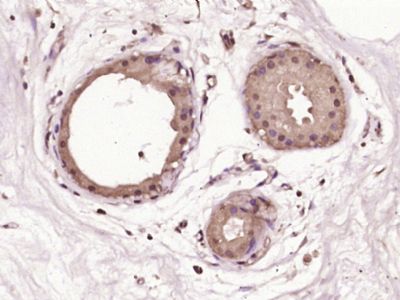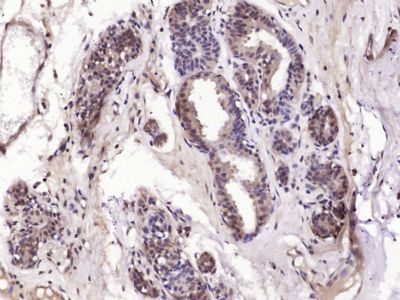ESE1 Polyclonal Antibody
Purified Rabbit Polyclonal Antibody (Pab)
- SPECIFICATION
- CITATIONS
- PROTOCOLS
- BACKGROUND

Application
| WB, IHC-P, IHC-F, IF, ICC, E |
|---|---|
| Primary Accession | P78545 |
| Reactivity | Rat, Dog, Bovine |
| Host | Rabbit |
| Clonality | Polyclonal |
| Calculated MW | 41 KDa |
| Physical State | Liquid |
| Immunogen | KLH conjugated synthetic peptide derived from human ESE1 |
| Epitope Specificity | 201-300/371 |
| Isotype | IgG |
| Purity | affinity purified by Protein A |
| Buffer | 0.01M TBS (pH7.4) with 1% BSA, 0.02% Proclin300 and 50% Glycerol. |
| SUBCELLULAR LOCATION | Cytoplasm. Nucleus. Localizes to the cytoplasm where it has been shown to transform MCF-12A mammary epithelial cells via a novel cytoplasmic mechanism. Also transiently expressed and localized to the nucleus where it induces apoptosis in non-transformed breast epithelial cells MCF-10A and MCF-12A via a transcription-dependent mechanism. |
| SIMILARITY | Belongs to the ETS family. Contains 1 ETS DNA-binding domain. Contains 1 PNT (pointed) domain. |
| SUBUNIT | Interacts with TBP. Interacts with CREBBP and EP300; these act as transcriptional coactivators of ELF3 and positively modulate its function. Interacts with XRCC5/KU86 and XRCC6/KU70; these inhibit the ability of ELF3 to bind DNA and negatively modulate its transcriptional activity. Associated with CLND7 and POU2F3. |
| Important Note | This product as supplied is intended for research use only, not for use in human, therapeutic or diagnostic applications. |
| Background Descriptions | ESE-1, a member of the Ets family of transcription factors, critically regulates epithelial cell differentiation and mediates vascular inflammation. ESE-1 is strongly expressed in vascular endothelium and smooth muscle cells where it is induced in response to inflammatory cytokines and lipopolysaccharides, interacts with NF-KappaB to induce nitric oxide synthase, and is induced during terminal differentiation of epidermal and primary keratinocytes. In addition, ESE-1 is upregulated upon differentiation of corneal epithelium and interacts with Sp1 and AP-1 proteins to induce squamous differentiation marker expression in bronchial epithelial cells. |
| Gene ID | 1999 |
|---|---|
| Other Names | ETS-related transcription factor Elf-3, E74-like factor 3, Epithelial-restricted with serine box, Epithelium-restricted Ets protein ESX, Epithelium-specific Ets transcription factor 1, ESE-1, ELF3 (HGNC:3318) |
| Target/Specificity | Expressed exclusively in tissues containing a high content of terminally differentiated epithelial cells including mammary gland, colon, trachea, kidney, prostate, uterus, stomach and skin. |
| Dilution | WB=1:500-2000,IHC-P=1:100-500,IHC-F=1:100-500,ICC=1:100-500,IF=1:100-500,ELISA=1:5000-10000 |
| Storage | Store at -20 ℃ for one year. Avoid repeated freeze/thaw cycles. When reconstituted in sterile pH 7.4 0.01M PBS or diluent of antibody the antibody is stable for at least two weeks at 2-4 ℃. |
| Name | ELF3 (HGNC:3318) |
|---|---|
| Function | Transcriptional activator that binds and transactivates ETS sequences containing the consensus nucleotide core sequence GGA[AT]. Acts synergistically with POU2F3 to transactivate the SPRR2A promoter and with RUNX1 to transactivate the ANGPT1 promoter. Also transactivates collagenase, CCL20, CLND7, FLG, KRT8, NOS2, PTGS2, SPRR2B, TGFBR2 and TGM3 promoters. Represses KRT4 promoter activity. Involved in mediating vascular inflammation. May play an important role in epithelial cell differentiation and tumorigenesis. May be a critical downstream effector of the ERBB2 signaling pathway. May be associated with mammary gland development and involution. Plays an important role in the regulation of transcription with TATA-less promoters in preimplantation embryos, which is essential in preimplantation development (By similarity). |
| Cellular Location | Cytoplasm. Nucleus {ECO:0000255|PROSITE-ProRule:PRU00237, ECO:0000269|PubMed:10391676, ECO:0000269|PubMed:15169914, ECO:0000269|PubMed:17060315} Note=Localizes to the cytoplasm where it has been shown to transform MCF-12A mammary epithelial cells via a novel cytoplasmic mechanism Also transiently expressed and localized to the nucleus where it induces apoptosis in non-transformed breast epithelial cells MCF-10A and MCF-12A via a transcription-dependent mechanism |
| Tissue Location | Expressed exclusively in tissues containing a high content of terminally differentiated epithelial cells including mammary gland, colon, trachea, kidney, prostate, uterus, stomach and skin |

Thousands of laboratories across the world have published research that depended on the performance of antibodies from Abcepta to advance their research. Check out links to articles that cite our products in major peer-reviewed journals, organized by research category.
info@abcepta.com, and receive a free "I Love Antibodies" mug.
Provided below are standard protocols that you may find useful for product applications.
If you have used an Abcepta product and would like to share how it has performed, please click on the "Submit Review" button and provide the requested information. Our staff will examine and post your review and contact you if needed.
If you have any additional inquiries please email technical services at tech@abcepta.com.













 Foundational characteristics of cancer include proliferation, angiogenesis, migration, evasion of apoptosis, and cellular immortality. Find key markers for these cellular processes and antibodies to detect them.
Foundational characteristics of cancer include proliferation, angiogenesis, migration, evasion of apoptosis, and cellular immortality. Find key markers for these cellular processes and antibodies to detect them. The SUMOplot™ Analysis Program predicts and scores sumoylation sites in your protein. SUMOylation is a post-translational modification involved in various cellular processes, such as nuclear-cytosolic transport, transcriptional regulation, apoptosis, protein stability, response to stress, and progression through the cell cycle.
The SUMOplot™ Analysis Program predicts and scores sumoylation sites in your protein. SUMOylation is a post-translational modification involved in various cellular processes, such as nuclear-cytosolic transport, transcriptional regulation, apoptosis, protein stability, response to stress, and progression through the cell cycle. The Autophagy Receptor Motif Plotter predicts and scores autophagy receptor binding sites in your protein. Identifying proteins connected to this pathway is critical to understanding the role of autophagy in physiological as well as pathological processes such as development, differentiation, neurodegenerative diseases, stress, infection, and cancer.
The Autophagy Receptor Motif Plotter predicts and scores autophagy receptor binding sites in your protein. Identifying proteins connected to this pathway is critical to understanding the role of autophagy in physiological as well as pathological processes such as development, differentiation, neurodegenerative diseases, stress, infection, and cancer.



